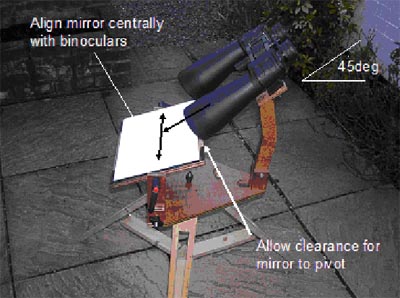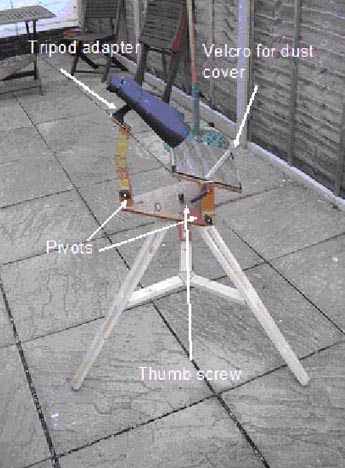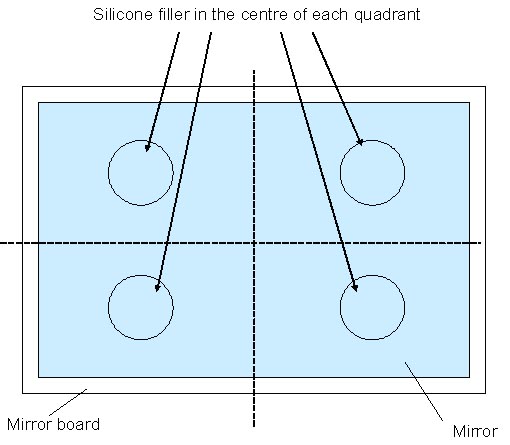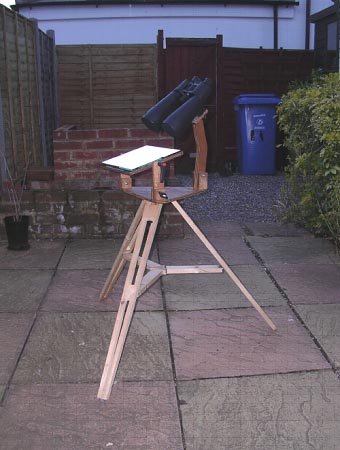| This
method, however, does not allow observations of the zenith as it is nearly impossible
to look through the eyepieces with the binoculars pointing at or near to the vertical.
It was also found to be very uncomfortable to observe at high elevations as the
head has to be tilted back for extended periods. Ironically, the zenith is the
optimum part of the sky to observe as the effects of atmospheric dimming are reduced
when compared to lower elevations. A method was required to allow a binocular observing programme to continue without undue discomfort. The objectives of this project were: ·
To allow binocular observing from horizon to zenith with complete comfort An internet search revealed three promising designs. The first was a pair of binoculars with a right angled prism or diagonal similar to those found on a refractor or SCT. This product is considerably more expensive than traditional straight through binoculars and was therefore discarded. An alternative product was a chair with an integral arm that supported the binoculars at head height. As the chair rotated and tilted, so do the binoculars. This design could be made relatively cheaply but would be limited by a lack of storage space. An alternative design was to mount the binoculars in a comfortable position and to use a small flat mirror to reflect the starlight from overhead through the binoculars. It was the third design, a mirror mount that was pursued. Design Process There are two alternative methods that can be pursued. The first is to fix the angle between the mirror and binocular and tilt the whole mount or to fix the binocular position and to tilt the mirror. A preference for having the binoculars at a fixed position means that the observer does not have to adjust the mount or eye height. This mount was designed around a pair of 15x70 Strathspey binoculars. Although relatively large by traditional standards, these binoculars are in the mid-range of commercially available binoculars. Larger binoculars such as the Fujinon 25x150 are too heavy for the mount presented here although a more robust mount could be developed quite easily from the principles presented. The binoculars were measured to determine the outer objective width and length (distance from mounting thread to objectives). The next stage is to select a first surface mirror (FSM) . Such a mirror has two differences from a household mirror: ·
It is optically flat so imperfections are not noticed when using the binoculars |
 | The mirror can be sized geometrically by knowing the objective diameter and the outer width of the two objectives. The mirror shown above 203x150mm (8x6 inches). Knowing the mirror dimensions allows the mirror board to be sized. An additional 12mm width was added around the outer edge to avoid touching the mirror during use. Now that the mirror and its board sizes are known, the binocular position can be determined, again by geometry. There are three considerations: ·
The centre axis of the binoculars must align with the centre of the mirror Knowing these rules allowed the binocular plinth to be designed and positioned. |
Two mirror arms were also designed that can support the mirror board. To allow the plinth and mirror arms to collapse for storage, they were hinged about their respective bases by means of a bolt. They can be locked into position (either collapsed or ready for use) by tightening the thumb screws. Knowing the principle dimensions of the mirror mount allowed the detailed structure to be detailed, including pivot points, screw holes, tripod hole and the binocular adapter to be positioned. A set of drawings were then made using A4 graph paper and a mock up made using scrap wood as a "sanity check". |
| Construction
Notes The mirror mount was made from ~12mm (1/2" in old money) plywood from B&Q. Make sure you inspect the plywood board prior to purchase. I noticed a number of boards had gaps or voids as they are intended for the construction industry rather than optical engineering! The binocular arm was a laminate of 2 pieces, making it 25mm thick. An extension was added to the top to allow the 1 ¼" whitworth bolt (standard photographic tripod thread) on the binocular-tripod adapter to be tightened by hand. The arm was made with 2-off 22.5deg bends to make a 45deg bend for comfortable viewing. The wood cut was with a hand saw and sanded by hand. The parts were then glued and screwed together. The parts were coated in varnish, sanded and then re-varnished to give a fine finish.
The mirror was bonded to the mirror plate with silicone filler (used to fill gaps around windows, sinks, baths etcetera). This was done by marking up the mirror board as shown below and placing four blobs of nominally 20mm diameter and a few millimetres thick in the centre of each quadrant as shown below. Place 4-off 2p coins around the edge of the mirror board and then place the mirror on the silicone. The weight of the mirror will squidge the silicone until it rests on the coins. |  |
This ensures that the mirror is flat and parallel with the mirror board. Once
the glue has dried (in 24h) remove the 2p coins from the side. You now have a
mirror firmly bonded to the mirror board with a gap. This gap avoids the mirror
from distorting as the wood expands/contracts with changes in humidity. |
 |
Mark
Radice |
| Mark Radice is a well known amateur astronomer in the Wiltshire, Hampshire and Dorset areas and regularly organises star gazing evenings with binoculars and telescopes as part of the Salisbury Plain Observing Group |

